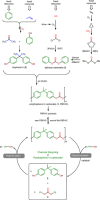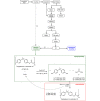Recycling of End-of-Life Poly(bisphenol A carbonate) via Alkali Metal Halide-Catalyzed Phenolysis
- PMID: 31304075
- PMCID: PMC6604237
- DOI: 10.1002/open.201900149
Recycling of End-of-Life Poly(bisphenol A carbonate) via Alkali Metal Halide-Catalyzed Phenolysis
Abstract
The chemical recycling of end-of-life plastic waste streams can contribute to a resource-conserving and sustainable society. This matter of recycling is composed of a sequence of depolymerization and subsequent polymerization reactions. In this regard, we have studied the chemical recycling of end-of-life poly(bisphenol A carbonate) applying phenol as depolymerization reagent. In the presence of catalytic amounts of alkali metal halides as products bisphenol A and diphenyl carbonate were obtained in excellent turnover frequencies of up to 1392 h-1 and short reaction times. These depolymerization products offer the straightforward possibility to close the cycle by producing new poly(bisphenol A carbonate) and as second product phenol, which can be reused for further depolymerizations.
Keywords: catalysis; depolymerization; green chemistry; polymers; recycling.
Conflict of interest statement
The authors declare no conflict of interest.
Figures



Similar articles
-
Hydrogenative Depolymerization of End-of-Life Poly-(Bisphenol A Carbonate) Catalyzed by a Ruthenium-MACHO-Complex.ChemistryOpen. 2019 Dec 11;8(12):1410-1412. doi: 10.1002/open.201900319. eCollection 2019 Dec. ChemistryOpen. 2019. PMID: 31867148 Free PMC article.
-
Hydrogenative Depolymerization of End-of-Life Polycarbonates by an Iron Pincer Complex.ChemistryOpen. 2020 Aug 11;9(8):818-821. doi: 10.1002/open.202000161. eCollection 2020 Aug. ChemistryOpen. 2020. PMID: 32789104 Free PMC article.
-
Chemical Recycling of End-of-Life Poly(lactide) via Zinc-Catalyzed Depolymerization and Polymerization.ChemistryOpen. 2020 Nov 2;9(12):1224-1228. doi: 10.1002/open.202000243. eCollection 2020 Dec. ChemistryOpen. 2020. PMID: 33304737 Free PMC article.
-
Chemical Recycling Processes of Waste Polyethylene Terephthalate Using Solid Catalysts.ChemSusChem. 2023 Jul 21;16(14):e202300142. doi: 10.1002/cssc.202300142. Epub 2023 May 26. ChemSusChem. 2023. PMID: 36972065 Review.
-
Perspectives for synthesis and production of polyurethanes and related polymers by enzymes directed toward green and sustainable chemistry.Appl Microbiol Biotechnol. 2006 Mar;70(1):12-20. doi: 10.1007/s00253-005-0269-2. Epub 2006 Jan 19. Appl Microbiol Biotechnol. 2006. PMID: 16421718 Review.
Cited by
-
Hydrogenative Depolymerization of End-of-Life Poly-(Bisphenol A Carbonate) Catalyzed by a Ruthenium-MACHO-Complex.ChemistryOpen. 2019 Dec 11;8(12):1410-1412. doi: 10.1002/open.201900319. eCollection 2019 Dec. ChemistryOpen. 2019. PMID: 31867148 Free PMC article.
References
-
- Plastics are typically composed of polymers and often other substances e. g. fillers, plasticizers, colorants.
-
- Landfill storage depends strongly on local regulations, e. g. in the European Union landfill storage has been limited to the necessary minimum (Landfill directive; see for instance:
-
- Burnley S., Resour. Conserv. Recycl. 2001, 32, 349–358;
-
- http://ec.europa.eu/environment/waste/landfill_index.htm (08. 03. 2019);
LinkOut - more resources
Full Text Sources

